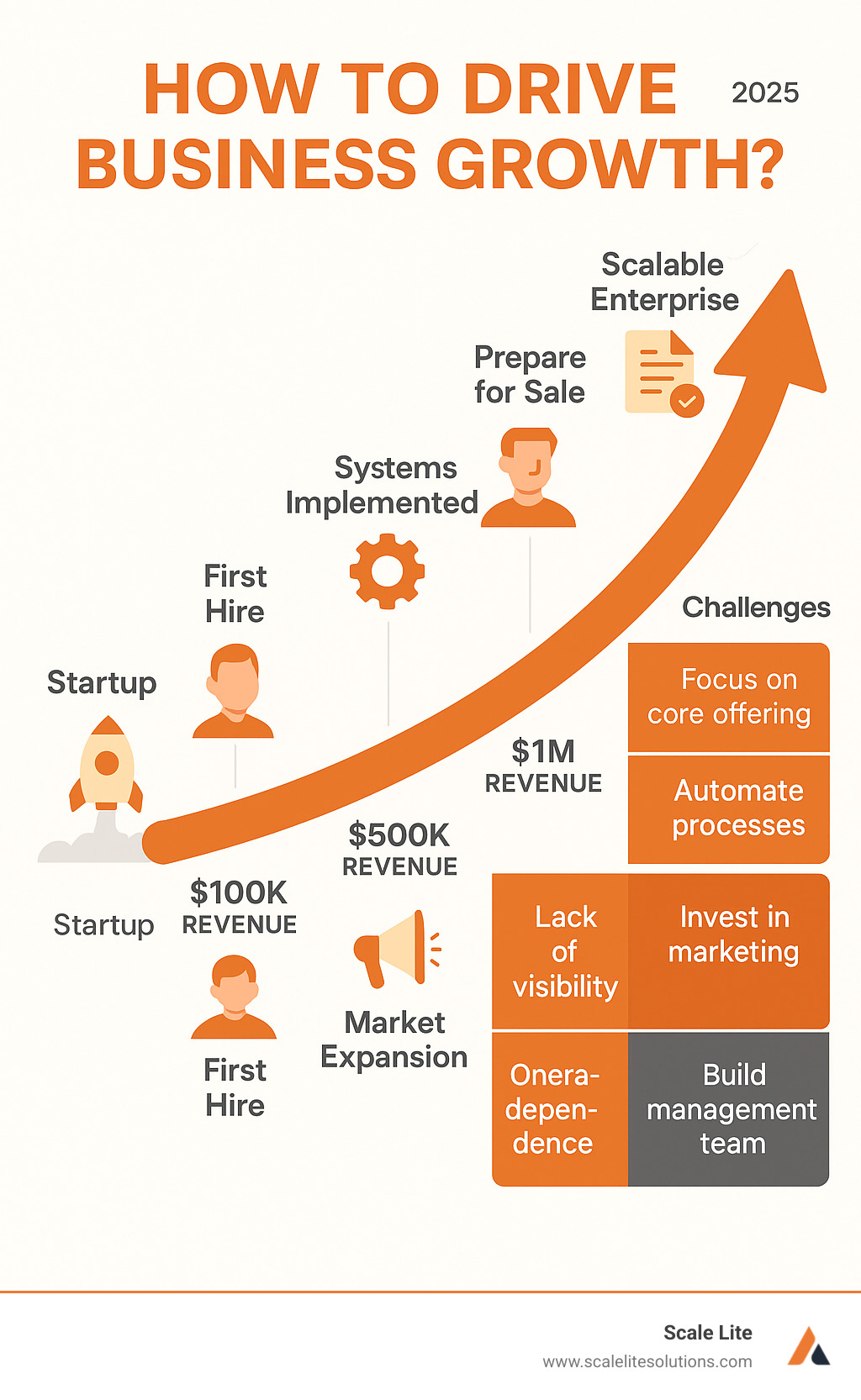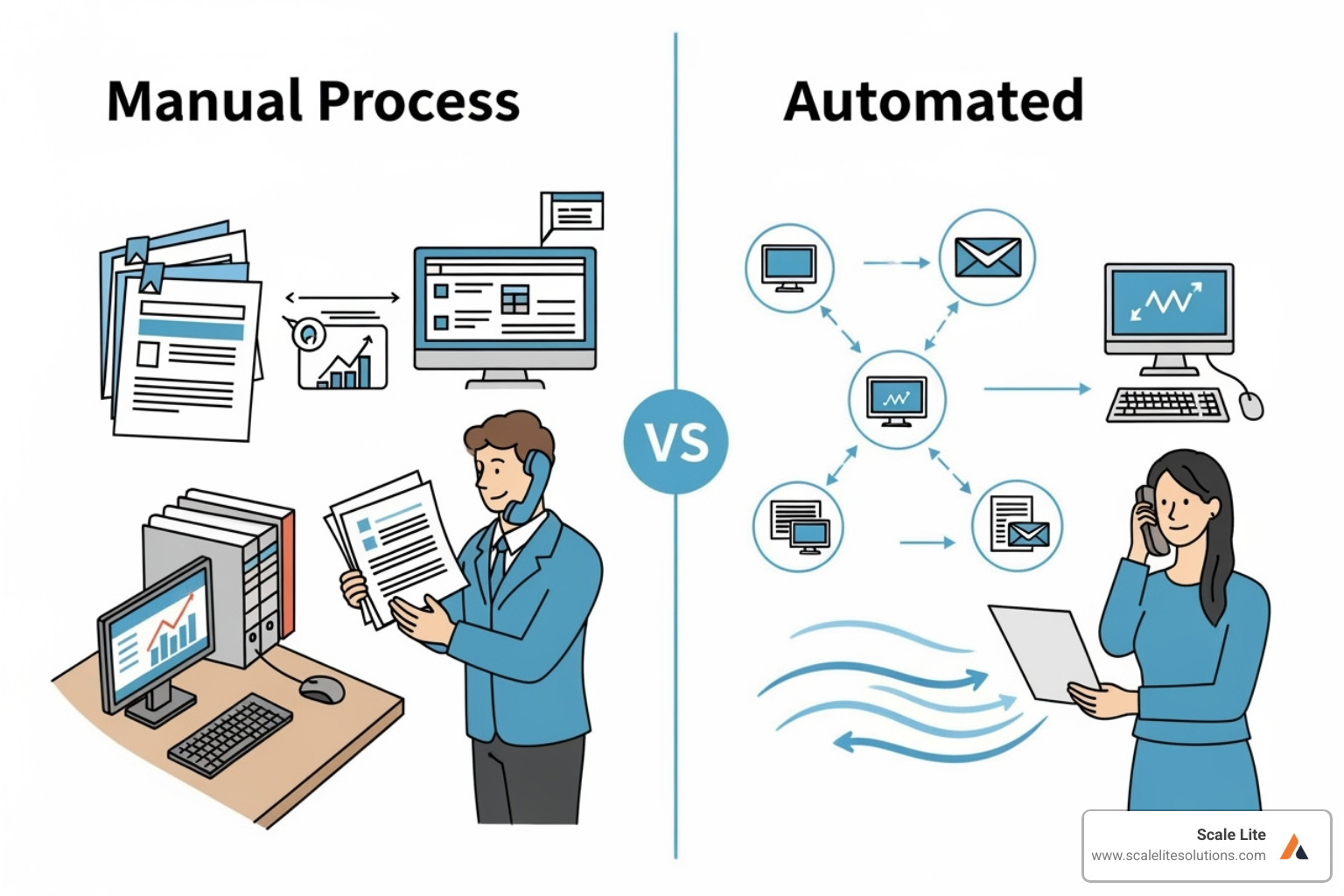
Grow Big or Go Home: How to Scale Your Service Business

Why Business Growth Is Essential for Service Companies
How to drive business growth? This question keeps countless service business owners up at night, and for good reason. According to research from McKinsey, only 25% of companies grow sustainably over time. Even more striking? Only 10% of companies maintain positive growth rates across a decade.
Here's the quick answer to drive business growth effectively:
Core Growth Strategies:
- Market Penetration - Dominate your current market with existing services
- Market Development - Expand into new geographic areas or customer segments
- Service Development - Add new services for existing customers
- Diversification - Enter completely new markets with new services
Implementation Essentials:
- Build customer loyalty (costs 5x more to get new customers than retain existing ones)
- Leverage technology and automation to reduce manual work
- Use data to make smart decisions about where to focus
- Create systems that work without you being involved daily
The harsh reality is simple: businesses that don't grow, die. As markets evolve and competition increases, standing still means falling behind. Growth isn't just about getting bigger - it's about building a business that can survive economic changes, attract better employees, and ultimately become valuable enough to sell when you're ready.
For service businesses especially, growth presents unique challenges. You can't just manufacture more widgets - you need more skilled people, better systems, and ways to maintain quality as you scale. The companies that figure this out build lasting value. Those that don't often find themselves trapped in businesses that depend entirely on the owner's daily involvement.
I'm Keaton Kay, and I've spent my career helping service businesses answer how to drive business growth through my work in private equity, enterprise sales, and now as founder of Scale Lite. I've seen what separates businesses that scale successfully from those that stay stuck, and I'll share that roadmap with you in this guide.

The Foundation: 4 Core Strategies for Service Business Expansion
When we talk about how to drive business growth, we're often talking about strategic expansion. To achieve sustained growth, companies need a well-defined plan or set of tactics. This isn't just about getting bigger; it's about growing your revenue, market share, customer base, or geographical footprint. These are the primary categories of business growth strategies that companies can employ, often visualized using a framework like the Ansoff Matrix.
This matrix helps us think about growth in terms of existing versus new markets, and existing versus new services. Let's break down these foundational approaches for service businesses. For more specific insights on our approach to service business growth, check out our Trades Business Growth Strategies.
Market Penetration: Dominate Your Current Turf
This strategy is all about doing more with what you already have. You're focused on increasing sales of your existing services to your existing customers or attracting new customers within your current market. Think of it like a local plumbing company that already serves a town. To achieve market penetration, they might:
- Increase customer loyalty: Implement a frequent service rewards program or offer discounts for repeat business. It's said to cost five times the amount to get a new customer than to retain an old one, making retention a highly profitable focus.
- Improve service quality: Consistently deliver top-notch work to generate positive word-of-mouth and online reviews. We've seen that 85% of people trust online reviews as much as personal recommendations, and most consumers read seven reviews before trusting a business.
- Increase brand recognition: Run targeted local ad campaigns, sponsor community events, or optimize their online presence to become the undisputed go-to provider in their city.
The goal here is to capture a larger share of the current market pie, ensuring you're getting the most out of your existing turf before venturing too far afield.
Market Development: New Territories, New Customers
Once you've maximized your current market, the next step is often to take your existing services to new places or new types of customers. This is market development. For example, an HVAC company that traditionally serves residential clients might begin offering their services to commercial buildings or expand into a neighboring county.
This strategy involves:
- New geographic areas: Opening new locations, expanding service territories, or even going national or international. A 2023 Forbes survey revealed that 79% of business owners were focused on expanding into new geographies, highlighting the ambition for this type of growth.
- New customer segments: Adapting your marketing and sales efforts to appeal to a different demographic or business type that could benefit from your existing services. Perhaps a cleaning company that usually serves homes starts offering services to small offices.
- Untapped markets: Identifying niches or underserved areas where your services could solve a real problem.
This approach allows you to leverage your proven service model and expertise in a fresh environment.
Service Development: More Ways to Solve Problems
This strategy focuses on creating new services to offer to your existing customer base. You already have their trust and attention; now, you're looking for additional ways to meet their needs. Think of a landscaping company that already maintains yards. They could add:
- New service offerings: Holiday lighting installation, pest control, or even minor handyman services.
- Upselling and cross-selling: Training technicians to identify additional needs during a service call and offer relevant solutions. For example, a plumber replacing a water heater might suggest a water filtration system.
- Innovation based on customer feedback: Actively listening to what your customers wish they had or what other problems they face, then developing solutions.
This approach deepens customer relationships and increases their lifetime value, making each existing customer even more valuable.
Diversification: Entering a Whole New Game
Diversification is the boldest and often riskiest growth strategy. It involves offering new services to new markets. While it has the highest potential for reward, it also comes with substantial risk if not properly planned. It's like a construction company leveraging its project management expertise to launch a separate property management division. They're using a core capability (project management) but applying it to a completely different market with a new service offering.
This strategy often involves:
- Strategic partnerships: Collaborating with other businesses to enter new markets or offer complementary services. This can be a great way to test the waters without full commitment.
- Mergers & Acquisitions (M&A): Acquiring another company that already operates in the new market or offers the new service. This is a common way for larger companies to diversify rapidly, though it comes with its own set of integration challenges.
- High risk, high reward: Because you're venturing into unfamiliar territory, thorough market research and careful planning are absolutely critical to mitigate potential downsides.
While diversification can lead to significant new revenue streams, it requires a strong understanding of both your new market and the unique demands of your new service.
The Modern Playbook: How to Drive Business Growth with Technology and Operations
In today's world, knowing how to drive business growth means more than just traditional market strategies. It means embracing operational excellence and leveraging technology. At Scale Lite Solutions, we believe in a holistic approach to growth, one that integrates cutting-edge AI deployment, workflow automation, data gathering through appropriate technology configuration, and CRM optimization. This improves operational efficiency and sustainable growth, ultimately driving enterprise value for our clients. For more on this, explore our insights on Digital Change Examples for Small Business.
How to Drive Business Growth by Mastering Your Market with Data
In the quest for growth, knowledge is power. Market research, goal setting, and performance monitoring are not just good ideas; they are fundamental to a successful growth strategy. They provide the compass to steer dynamic market environments.
Here's how we approach it:
- Market Research & Competitor Analysis: Before making any big moves, we dive deep into understanding your customers' needs, pain points, and preferences. We also carefully analyze your competitors to identify their strengths, weaknesses, and potential gaps you can fill. Tools like SimilarWeb can help us assess competitor strategies, from their website traffic to their marketing channels. This helps us understand the landscape and position you for success. For more, see our guide on Data-Driven Business Strategy.
- Goal Setting (SMART Framework): Once we know where you stand, we set clear, measurable goals. These aren't vague aspirations but specific, measurable, achievable, relevant, and time-bound (SMART) objectives. For instance, "Increase service bookings by 15% in the next quarter" is a SMART goal.
- Performance Monitoring (KPIs): We can't improve what we don't measure. Key Performance Indicators (KPIs) are the vital signs of your business. We track metrics like lead conversion rates, customer acquisition cost, customer lifetime value, and service delivery times. This continuous monitoring allows us to see what's working, what's not, and where to adjust our strategy. As the saying goes, "It is impossible to improve what cannot be measured."
Mastering your market with data allows us to make informed decisions, ensuring every growth initiative is backed by insight, not just guesswork.
How to Drive Business Growth by Building Unbreakable Customer Loyalty
Customer relationships, retention, and loyalty are not just buzzwords; they are the bedrock of sustainable business growth. It's far more efficient to keep an existing customer happy than to find a new one. As we mentioned, it costs five times the amount to get a new customer than to retain an old one. This isn't just a saying; research backs it up, as highlighted by InvespCRO.
Here’s how we help you foster loyalty:
- Customer Relationship Management (CRM): Implementing a robust CRM system is like having a superpower for customer management. It centralizes customer data, tracks interactions, and helps manage sales opportunities. This ensures no customer falls through the cracks and every interaction is personalized and effective.
- Referral Programs: Happy customers are your best marketing asset. We help design referral programs that incentivize existing clients to spread the word. A study by McKinsey and Co. found that 63% of Gen Z cite friend referrals as their most trusted source when shopping for new products, demonstrating the power of personal recommendations.
- Online Reviews & User-Generated Content: Online reviews are paramount. 85% of people trust online reviews as much as personal recommendations, and most consumers read seven reviews before trusting a business, according to a study by BrightLocal. We help you encourage positive reviews and leverage user-generated content (UGC), such as customer testimonials or photos of your work, to build trust and social proof. It's interesting to note that 46% of respondents are drawn to follow everyday people (influencers) while only 10.3% favor celebrities, indicating the power of authentic voices.
- Exceptional Post-Purchase Experience: The journey doesn't end after the sale. Customers who make a second purchase within 90 days of the first purchase are more than double the lifetime value of the average customer. This emphasizes the importance of consistent, high-quality service and proactive follow-ups to ensure long-term satisfaction.
By focusing on building unbreakable customer loyalty, you create a self-sustaining growth engine driven by repeat business and glowing recommendations.
Achieve Operational Excellence Through Automation
For blue-collar service businesses and companies in low-tech industries, achieving growth often means doing more with the same or fewer resources. This is where operational excellence through automation becomes a game-changer. We believe in working smarter, not just harder.

Automation is critical for scaling without significant increases in overhead:
- Workflow Automation: Many repetitive, time-consuming tasks can be automated. Think about the journey from a customer's first inquiry to the final invoice. We can automate processes like appointment scheduling, dispatching technicians, sending service reminders, generating invoices, and even follow-up communications. This frees up your team to focus on high-value activities and customer interactions.
- AI Deployment: The integration of AI solutions, such as AI Voice and AI Chat, can revolutionize your customer interactions. Imagine having a "team member" who works 24/7, never takes a break, and always delivers exceptional results. This is possible with AI. For example, AI can pre-qualify leads, answer frequently asked questions, and even book appointments. This means your team spends less time on "tire-kickers" and more time on high-value leads. We know that contractors who respond in under 5 minutes are 400% more likely to win the job, and AI can provide that instant response.
- Cost Reduction & Productivity: By reducing manual errors and streamlining processes, automation directly impacts your bottom line. It allows you to handle a greater volume of work without necessarily hiring more staff, leading to increased productivity and profitability.
- Scalable Service Operations: Automation builds the backbone for scalable operations. When your systems are automated, they can handle increased demand without breaking down, making your business more resilient and agile. We offer comprehensive Business Automation Services and insights on Scalable Service Operations to help you achieve this. Learn more about How to Achieve Operational Excellence in your business.
Embracing automation isn't just about efficiency; it's about building a future-proof business that can grow without limits.
Leverage Strategic Alliances and Advanced Growth Levers
Beyond the core strategies and technological advancements, some powerful, advanced levers can propel your business growth. These often involve collaborating with other entities or making significant structural changes to your business.
- Strategic Partnerships: This involves forming alliances with other businesses that offer complementary services but aren't direct competitors. For instance, a roofing company might partner with a solar installer, or a cleaning service might team up with a moving company. These partnerships expand your reach, provide new revenue streams, and offer added value to your customers. It's a win-win scenario that leverages existing customer bases.
- Franchising: If your service model is highly repeatable and profitable, franchising can be an explosive growth engine. It allows others to invest their capital and effort to replicate your success in new territories, while you earn royalties and expand your brand footprint. Many well-known service businesses, from fast food to fitness, have used franchising to achieve massive scale.
- Mergers & Acquisitions (M&A): Acquiring another business can be a fast track to growth, providing immediate access to new markets, customer bases, talent, or technologies. Conversely, divesting a non-core part of your business can also be a growth strategy—known as "shrinking to grow"—by freeing up capital and focus for more promising ventures. The podcast "Courageous Growth" discussed how companies that engage in such inorganic opportunities, including divestitures, can achieve outperformance. This also contributes to increasing your enterprise value.
- Agility and Adaptation: In a dynamic market, the ability to remain agile and adapt your growth strategies is paramount. This means continuously monitoring market trends, being willing to pivot when necessary, and fostering a culture of innovation. As the "Courageous Growth" podcast notes, a "through-cycle growth mindset" is necessary because challenging economic events are pervasive. Companies that thrive are those that can quickly adjust their sails to catch new winds.
These advanced levers, while potentially more complex, offer pathways to significant scale and increased enterprise value, moving you closer to becoming a hands-off business owner.
Frequently Asked Questions about Driving Business Growth
When we work with service business owners, the same questions about how to drive business growth come up again and again. These are smart questions from people who want to grow the right way - not just fast, but sustainably. Let me share the answers that have helped hundreds of businesses scale successfully.
What are the first steps to creating a growth plan?
Think of creating a growth plan like planning a road trip. You wouldn't just jump in your car and start driving - you'd figure out where you are, where you want to go, and the best route to get there.
Start with a deep dive into your current situation. This means conducting thorough market research to understand what your customers really want and need. You'll also want to study your competitors - not to copy them, but to see where gaps exist that you can fill.
Next, take an honest look at your own business through what's called a SWOT analysis - examining your Strengths, Weaknesses, Opportunities, and Threats. This internal evaluation helps you understand what you're working with and what needs improvement.
Finally, set SMART goals - ones that are Specific, Measurable, Achievable, Relevant, and Time-bound. Instead of saying "I want to grow my business," you might say "I want to increase monthly recurring revenue by 25% within the next 12 months by adding two new service lines."
This foundational work ensures your growth plan is built on solid ground, not wishful thinking.
How do I know if my business is ready to grow?
This is one of the most important questions you can ask. Growing too early can actually hurt your business, while waiting too long means missing opportunities.
Look for these key indicators that your business is ready to scale: You should have consistent profitability month after month, not just occasional good months. Your cash flow should be strong and predictable - you can forecast your income and expenses with confidence.
Another clear sign is when you're struggling to meet high demand. If you're turning away customers or booking them weeks out, that's a good problem to have. But here's the crucial part - your operational processes need to be solid first. If your current systems are chaotic, scaling will only create bigger chaos.
Think of it like building a house. You need a strong foundation before you can add a second story. If your scheduling is messy, your invoicing is inconsistent, or your customer service is hit-or-miss, fix those issues before trying to grow.
How can I fund my business growth?
Growth requires investment, but the good news is you have several options depending on your situation and goals.
The most sustainable approach is organic growth - reinvesting your business profits back into expansion. This is why profitable growth matters so much. When you're making money consistently, you can fund new equipment, hire additional staff, or expand your service area without taking on debt.
For faster growth, you might consider small business loans from banks or credit unions. These work well when you have a clear plan for how the money will generate returns. Lines of credit offer more flexibility for operational expenses that fluctuate with growth.
Some businesses also seek out investors who bring both capital and expertise. This can accelerate growth significantly, though it means sharing ownership and decision-making.
Regardless of which funding route you choose, remember this: a solid, well-researched business growth plan is essential. Lenders and investors want to see that you've thought through the details and have a realistic path to success. The stronger your plan, the better your funding options will be.
Conclusion: Your Blueprint for Building a Business That Lasts
Understanding how to drive business growth isn't a destination you reach and then forget about. It's more like tending a garden - it requires ongoing attention, strategic planning, and the flexibility to adapt when conditions change. The businesses that truly thrive are those that accept a holistic approach, weaving together market expansion with operational excellence and smart technology use.

Think of it this way: you wouldn't build a house on a shaky foundation and expect it to last through storms. The same principle applies to your business. The power of systems lies in creating that solid foundation - one that can support growth without cracking under pressure.
The most successful service businesses we work with understand that sustainable growth comes from building enterprise value through systems that work consistently, whether the owner is there or not. These are the businesses that run themselves - not because they're on autopilot, but because they're built on reliable, repeatable processes.
At Scale Lite Solutions, we've seen how blue-collar service businesses and companies in low-tech industries can open up their full potential. Our approach focuses on creating robust systems while leveraging technology like AI and automation to make your operations more efficient and your growth more predictable.
Here's what we've learned: the businesses that last are those that don't just chase growth for growth's sake. They build with intention, creating value that extends beyond today's revenue. They understand that true success means creating something bigger than themselves - something that can thrive and grow even when they're not working 80-hour weeks.
The journey from where you are now to where you want to be doesn't have to be overwhelming. With the right strategy, the right systems, and the right support, you can transform your service business into something that not only grows but becomes increasingly valuable over time.
Ready to take that next step? Don't let the challenges of scaling hold you back. Take the next step to transform your service business with a proven, technology-driven approach. Find how automation and AI can fuel your growth and start building the business that will serve you for years to come.








